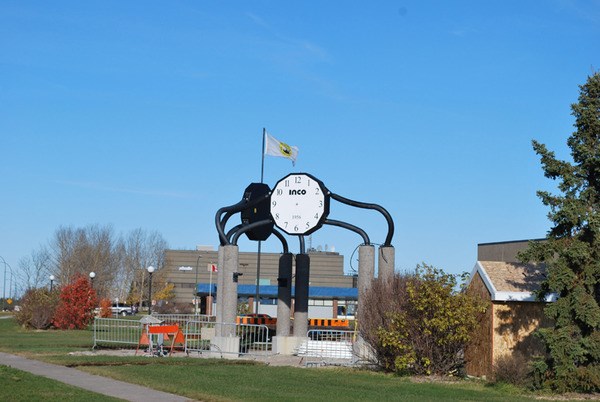Mayor Tim Johnston says he's still expects the Thompson Community Clock - a 50th anniversary project from 2006 - to be completed in front of City Hall this year.
The community project, honouring John Fairfield Thompson, the chairman of Inco when Borehole 11962 - the so-called "Discovery Hole" at Cook Lake, a diamond drill exploration hole - was collared Feb. 5, 1956 and assayed positive for nickel, dates back four years.
In recent weeks, the twin clocks were finally mounted - prominently displaying the word "INCO," the former name for Vale, and "1956" the year Thompson was founded. The two clock faces and electronic controls sat in a warehouse in Thompson for almost two years awaiting installation.
The clocks have white faces and black numerals from 1 to 12 and 12 sides, much like the shape of Canadian nickels from the era. The choice became obvious to create the design in the shape of a nickel coin, as nickel is the ore, which has become the city's central industry provider, local jeweller Don Johnson Jr., who was instrumental in the clock face design, noted earlier.
While Johnson came up with the faceplate idea for the clock, much of the detailed structural design work for the clock mounting - 19 pages of drawings in all - was done by volunteer Bruce Ecker, a local artist who works at Vale in the engineering department and was asked in June 2007 to undertake the 3-D work and delivered the drawings in October 2007.
The hands weren't installed as of Oct. 11.
"I understand there is still some work to be done with electrical," Johnston said last Friday. Brad Ritchie at the Thompson Community Foundation and "Donny Johnson are leading the project at this stage.
Please remember this project is being completed largely by volunteers who are doing a great job. I understand the plan remains to complete the project including landscaping by the City this year," Johnston said.
The twin clocks, each six feet in diameter, stand on aggregate concrete pillars in front of City Hall, one facing northwest and the other southwest.
Dual steel pipes connect the two clocks manufactured in Massachusetts.
The clock faces will also be lit, with special engineering employed to handle Thompson's cold winters. Ground lighting will also keep the clocks looking bright year-round.
From the beginning of his career with Inco, in 1906,
John Fairfield Thompson played important roles in developing and encouraging the expanded use of various nickel alloys, introducing them to the textile, chemical, power and food service industries.
In 1918, he established the first technical department.
Following the First World War, when Inco wanted to expand its commercial markets. Thompson was responsible for supervising both the construction and initial operations of a rolling mill in Huntington, West Virginia.
His laboratory experience, combined with a practical approach to product development contributed to the successful production of new alloys for commercial use. He guided Inco toward making new products such as nickel alloy wire and tubing.
In 1948, Thompson approved funding for a project to develop the stainless steel kitchen sink, the single largest application of the alloy in the world. Thompson became president of Inco in 1949, a position he held for three years until 1952. He became chairman in 1951 and remained in that role until his retirement in April 1960.
After two years of waiting in vain for volunteer help, the City of Thompson decided in June to pay a cement contractor to form and make the exposed aggregate to finish the vertical columns, which long held up completion of the project.
"The expense for above will be borne from operating budgets for the year I think it was about $5,000 for clock cement, which the city will get back from the Thompson Community Foundation," Johnston said earlier.
Other aspects of the clock project have had lots of successful volunteer help, but the completion of the critical specialized cement work was long a sticking point.
The foundation was put in place in the fall of 2008, compliments of Schwartz Bros. Construction. Mutschel Bros. constructed the steelwork, including the tower and pedestal that it will rest on, and the cement for the base was donated by Multicrete Systems Inc.




